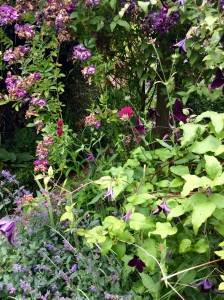
The season is far from over. At Writtle University College, the seasonal bedding is really at its best this time of year.
Over the last few years we have tried to make it a little more sustainable by using plants that are self-supporting, cover the ground and so block out weed growth that doesn’t require lots of deadheading. The same can be said for our mixed borders around the campus.
A mixed border may contain trees, shrubs, herbaceous plants and bulbs. Modern gardens tend to be small and may be better suited to a mixed border that can give interest throughout the year.
For me the advantages of a mixed border are many:
- Labour is expensive and it may be difficult to afford to maintain large areas of herbaceous plants.
- Herbaceous borders do not provide sufficient all year interest so trees, shrubs, herbaceous plants and bulbs are all grown together in a mixed border to provide extra colour and interest.
- Shrubs are used to give structure.
- Flowering and fruiting shrubs can provide interest in winter and spring.
- Shrubs grown for their foliage colour can provide an effective foil or backdrop.
- Herbaceous plants add to the seasons of interest especially in a small garden, by providing flowers and foliage at times when shrubs may be less interesting.
There are a few disadvantages of a mixed border such as:
- Mixed borders can be difficult to plan
- A range of skills is needed as trees and shrubs have to be pruned
- Mixed borders may suffer from trying to look interesting at all times of the year
So if you want to add a new border this year why not consider a mixed one. Consider the following:
- The soil must be fertile, and well drained, with plenty of organic matter and moisture.
- The area should be free of perennial weeds, pests and diseases.
- The site must be sunny and open, away from overhanging trees; otherwise the plants become drawn and do not flower well. This is less important for foliage plants.
- The site should be sheltered so that the wind does not damage plants.
Start planning now and preparing for planting out later this autumn or early spring. If you’re sprucing up and existing areas these times are ideal for lifting up key plants and dividing them. This simple technique enables you to keep young plantlets and discard and compost poor growth.
As far as maintenance goes check out my simple steps to success:
Fertilisation – an annual application in spring of a balanced fertiliser such as Growmore @ 100 g/m² or blood, fish and bone @ 70 g/m²
Weeding – regular weeding will be required, particularly in the spring and early summer
Staking – this is best carried out before required. Materials used range from pea sticks, or lengths of hazel coppice, to bamboo canes and metal linking stakes. Staking should be as unobtrusive as possible to allow the natural form of the plant to develop and should be 15-30 cm shorter than the ultimate height of the plant
Division – herbaceous plants require regular division to keep them floriferous and healthy. This is carried out in the autumn or spring
Irrigation – irrigation may be necessary in prolonged dry periods or when plants are establishing. Ground level irrigation systems such as porous pipes use water efficiently and do not damage flowers and foliage. As with all irrigation a thorough soaking is preferable to a light sprinkling, in order to encourage plants to develop deep root systems
Dead heading – dead head where possible as this will encourage a longer flowering season
Pests and diseases – Monitor and treat pests and diseases accordingly. Commonly occurring problems include aphids and powdery mildew.
Use this site for further information https://www.rhs.org.uk/science/plant-health-in-gardens
Mulching – an annual application of a layer of leaf mould, well-rotted farmyard manure or garden compost helps to reduce weed seed germination and conserves soil moisture and improves soil structure.
Good luck and happy gardening!
For any gardening tips why not contact Tom Cole, Senior Horticultural Lecturer, Writtle College, Chelmsford, CM1 3RR by post (including a SAE) or by email at tom.cole@writtle.ac.uk








